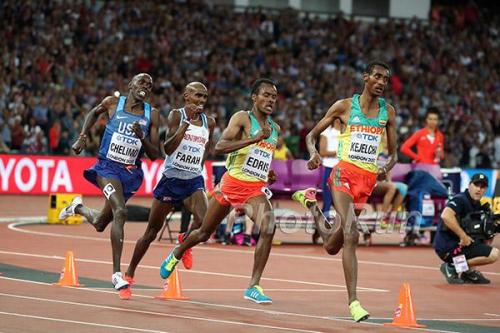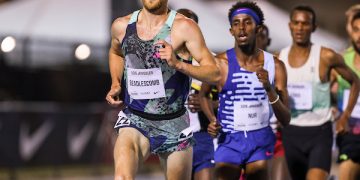 Paul Chelimo, Mo Farah, Muktar Edris, Yomif Kejelcha, photo by PhotoRun.net
Paul Chelimo, Mo Farah, Muktar Edris, Yomif Kejelcha, photo by PhotoRun.net
This column was written by Elliott Denman on the plethora of NCAA students in London this week. Watch for his sly comment on the NCAA not supporting race walkers. They sure can afford it.
5000-METER TITLE RACE
AGAIN PROVES THAT
USA COLLEGIATE SYSTEM
IS A WINNER
By ELLIOTT DENMAN
LONDON – Now, maybe more so than ever, there’s a lot to be said for the USA’s national collegiate system.
A huge heap of events here at the 16th IAAF World Championships of Track and Field
have been impacted by the guys and gals who’ve competed for – or continue to compete
for – NCAA schools (of whatever division) or their cohorts out of the NAIA ranks.
For perfect example:
Omar McLeod of Jamaica, the Worlds (and Olympic) men’s 110-meter high hurdles
champion? He’s a University of Arkansas man.
Bagrbara Spotakova, the World’s women’s javelin champion? She honed her craft at Minnesota.
Ekaterina Stefanidi, the World’s women’s pole vault titlist? She’s a Stanford woman.
Plus – of course, of course, of course – the long, long, long list of Americans who’ve come up through the ranks of their own nation’s collegiate system.
Driving home the point all over again was the men’s 5000-meter final, a big-big feature event on the
penultimate night of these Worlds.
Check out these final standings:
As the gold was going to Ethiopia’s Muktar Edris (13:22.79) in his drama-packed and
oh-so-narrow decision over the home team’s hero of heroes, Mo Farah (13:33:22), the bronze was going (in 13:33.30) to USA’s Paul Chelimo, who’d run for the University of North Carolina at Greensboro after emigrating from Kenya.
Grabbing sixth place in 13:35.43 for Canada was another Mo, Ahmed of the University of Wisconsin.
In ninth place, clocked in 13:39.15 and doing a great job, too, for Canada, was Syracuse University
student Justyn Knight.
Right behind Knight, with a 13:39.74 performance in 10th, was former Arkansas athlete Kemoy Campbell, running for Jamaica – and making his personal point that they have a lot of athletic folks from his home island who don’t happen to be sprinters.
And winding up one spot back of Campbell, 11th in 13:43.25, was the reigning NCAA Division I
cross country champion, Villanova University’s Patrick Tiernan, running for Australia.
When the pace sagged in the race’s middle laps, it was Tiernan who gutsily took it over
and had himself a 10-15-meter lead at various points.
Sally Pearson of Australia had just won the women’s 100-meter hurdles title in the event
staged just before the 5000 final, so when Tiernan bolted into the lead, there were some
Aussies in the vast audience visualizing the longest-shot possibility of consecutive
gold medal performaces by the stars of Oz.
It hadn’t been a stirring World Championships through the first eight days of these Worlds
for their team, but here they had the incredible sight of Aussies going for two straight.
Reality, of course, eventually set in a few laps later when the field overwhelmed
Tiernan and he had no response.
Still, he had made his point, and had tred to keep the pace at least somewhat
“honest.”
In short, he’d given it “the old college try.”
And his college happened to be located – not Down Under – but the Main Line of the Philadelphia suburbs.
Let’s hear it, too, for the NAIA – the small-school organization forever in the NCAA’s shadow and forever in danger of being completely gobbled up by all those big guys.
But there’s huge NAIA rooting interest here and it’s not where you’d ordinarily expect.
The NAIA, you see, embraces the art of racewalking while the NCAA tells the racewalking world to, in effect, just go for a long walk in some opposite direction.
Which brings us to Evan Dunfee.
He’s a University of British Columbia man who, after winning NAIA titles, has risen through the ranks as one of the world’s finest 50K racewalkers.
Be sure to check out Dunfee’s performance in the Sunday morning Worlds 50K race.
Canada loves him. NAIA fans love him. It’s the NCAA that doesn’t give a hoot.
Author

One of the finest and most prolific writers in our sport, Elliott Denman has written about our sport since 1956, when he represented the US in 1956 Olympic Games at the 50k race walk, the longest event on the Olympic schedule. A close observer of the sport, Elliott writes about all of our sport, combining the skills of a well honed writer with the style of ee Cummings. We are quite fortunate to have Elliott Denman as a friend and advisor.
View all posts




















